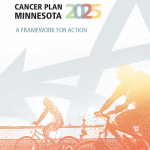
Scott Nelson
A patient’s perspective on the information and resources we need and that we expect our cancer center will provide.
The cancer patients journey often starts with vague and uncomfortable symptoms, and it can sometimes take weeks or longer working with doctors to find the cancer.
When we get the cancer diagnosis, there’s shock (felt I’ve been hit by a truck), followed by disbelief (how can this be), then anger (why me), and finally resolution (I’ll fight this). Once we’ve decided to fight, there’s confusion (what do I do to fight this). You start your search for the information and resources you’ll need, and often times find it very difficult to locate them.
We have to make life and death decisions in a very short time often with very little information. Decisions including but not limited to: doctor choice; type of treatment; getting a 2nd opinion or not, and if so where and how; if I need a clinical trial how do I find one; what support resources will I need; what support resources will my family need; how do I navigate the medical system the best way; etc. etc.
I was very fortunate. I had a proactive local doctor who diagnosed me, and got a 2nd opinion at a medical center with expertise in my type of cancer. I found an outstanding oncologist and a top local surgeon for my type of cancer, and there was a clinical trial available that matched my treatment needs and that I qualified for. I had wonderful support from family, friends and co-workers. And still the entire diagnosis, treatment and survivor process was incredibly difficult.
In an article by Futurity, an organization of scientists at top research universities in the US, UK, Canada and Australia sharing research news directly with the public, results from a comprehensive study: “On tools to facilitate communication during physician‐patient consultations in cancer care: An overview of systematic reviews” was shared. The study was published in CA; A Cancer Journal for Clinicians. In a quote from the article, “James Bonnamy was 31 years old when he was diagnosed with colon cancer. He had a lot of questions about his diagnosis and treatment, but in the beginning, the whole process was overwhelming. “One of the hardest things throughout my cancer journey was having to constantly make decisions when I felt I didn’t have enough information, have any real options, or was ready,” he says…. Effective and open communication is linked with stress reduction, improved pain control, greater understanding of and adherence to treatment, speedier recovery, and better quality of life.”
Continuing work to improve doctor / patient communication is critical, and having access to patient navigator / care coordinator resources is important, but providing the quality of cancer care that your patients expect requires more than that. As a cancer center providing care for patients, you need to provide the right information, at the right time to patients and their families. This information needs to be delivered in a variety of ways to best match the abilities and preferences of your patients. Patients start gathering information immediately after diagnosis. Start by identifying all the places in your medical system where patients could receive a cancer diagnosis. I was diagnosed by my general practitioner. Others are diagnosed by surgeons, oncologists, radiologists… Wherever a diagnosis can be made, there should be information for patients as to where to go to start getting the information they’ll need. I was diagnosed on a Friday and told by the affiliated cancer center to come back on Monday when the doctors were in. I had no information other than that I was just diagnosed with cancer. That was the worst weekend of my life.
The initial information to patients can be as simple as a pamphlet listing contacts for resources in your medical system that can help us and pointing us to your website. Your website needs to be easy for patients and their families to navigate. It should have an easy to find cancer section that is filled with the information newly diagnosed patients will need. Your website needs to include information on what to expect as we go through the cancer care process and which decisions we’ll have to make, and include information to help us make them. It should include a list of questions to ask our doctor. Your website should also detail a listing of the resources available at your cancer center and in our community and how to access them. Look at your website through the eyes of a newly diagnosed patient, who is in emotional distress from the diagnosis, and has no idea what to do next. Access to patient manuals or videos if you have them are important as well. How is your medical center doing at providing the information patients need and the direction to the resources you have, and resources that are available in the community and nationally?
The resources you have in your medical center are important to your patients and their families. Are your patients utilizing the resources you have available? If not, you need to look at how you can improve the communications to patients about them and what you can do to make them more accessible. You should also include the available resources in our local community and nationally. The community and national resources can be valuable in providing services important to us that you don’t offer. These resources can be specific to the community we live in, and to the type of cancer I have. Community based support is important, and nationally there are survivor networks and other cancer advocacy resources specific to my cancer. There are a lot of resources available, but patients are often left on their own to find them. To provide the best care, you need to determine how you can connect the right resources at the right time to the patient and their families.
There is a patient satisfaction / market share multiplier effect for cancer centers that medical centers treating other diseases often don’t have. When a person is diagnosed with cancer, their family, friends and neighbors gather around to support them in any way that they can. They stay in touch throughout the cancer care process, and they know whether or not the patient is satisfied with the care they’re receiving. They’re likely to share that information with people they know who may also be in need of cancer care. I’ve worked with a local cancer center on their cancer care from the patient information and resources perspective. With the changes they made in their cancer patient experience, they saw an increase in both patient satisfaction scores and market share.
The expectations of your cancer patients are straightforward:
We will be provided with the information we need and you will tell us what to expect, what to do, and help us best navigate through treatment and beyond.
We will have access to the resources needed to get us through this in the best way, and you will identify and utilize those resources on our behalf.
To meet those expectations, a cancer center needs to:
- Review your cancer patient experience step by step, from a patient perspective related to needed information and resources. It must be the right information and the right resources, at the right time, and delivered the right way.
- Ensure that the information needed at each point in the cancer care experience is identified and that it’s being delivered timely and in the best way, including offering clinical trial participation if appropriate.
- Review the resources that are available in your cancer center, as well in the local community and nationally, and determine how you can connect the right resources at the right time to the patient and their family.
- Understand the emotional and physical impact a cancer diagnosis has on the patient and family decision-making process, and make that an important consideration in how information and resources are delivered.
- Identify the stars in your organization who have developed best practices around information delivery and resources and extend them to the rest of your team.
- If you don’t have already them, build cancer support groups, a patient advisory board, and if you’re doing research, cancer center research advocacy groups.
- Get your former patients involved. Many of them want to help improve the cancer care process. They don’t want others to have to go through the difficulties they and their families did in their fight against cancer.
Scott Nelson is a pancreatic cancer survivor, clinical trial participant, and patient advocate. As part of a national survivor’s network, he provides counsel and hope to newly diagnosed cancer patients. He’s worked directly with local cancer centers to improve patient care. He’s a Research Advocate for Mayo Clinic, and is the Patient Advocate on a SU2C Interception Dream Team with researchers from Dana Farber, M.D. Anderson, Johns Hopkins, Mayo, UCSD and MIT, working on a group of cancer interception initiatives including among others: an online genetic testing solution to identify high risk family members; a cancer vaccine for use by high risk individuals to stop cancer from starting; blood tests to both identify cancer risk and to diagnosis cancer; and improving cancer screening by using deep learning to train computers to read cancer scan images.
The MCA Cancer Plan Minnesota 2025 objectives this article speaks to are:
Objective 5 Support Services
5.1 Strengthen the ability of cancer programs to implement cancer navigation processes that assess needs and make connections to needed resources and services
5.2 Convene providers to promote best practices and evidence-based protocols for shared decision making during cancer treatment
Objective 6 Patient Navigation


